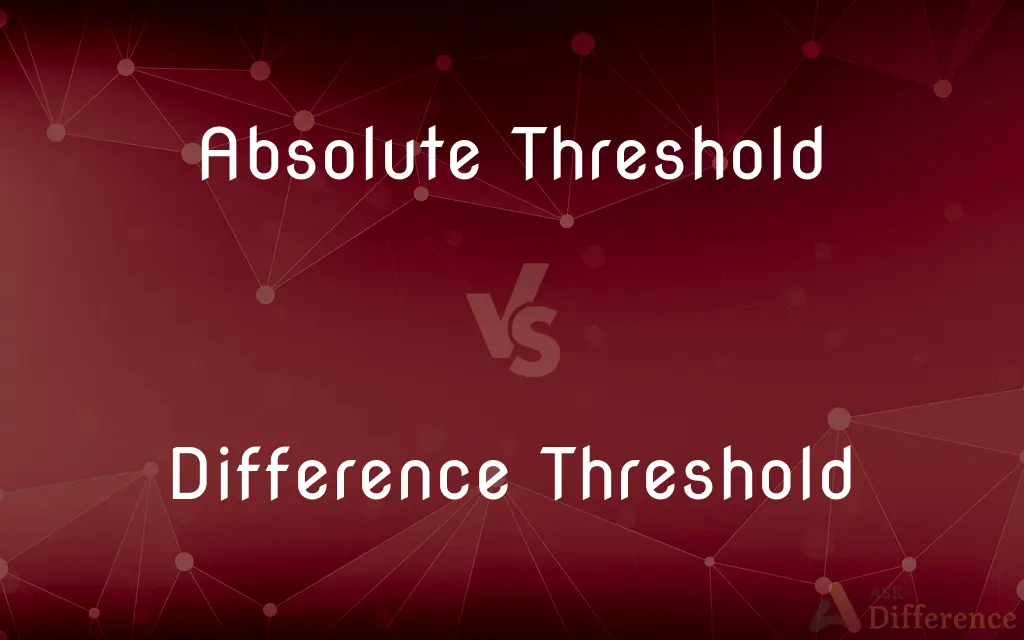Absolute Threshold vs. Difference Threshold — What's the Difference?
By Tayyaba Rehman — Published on November 8, 2023
The Absolute Threshold is the minimum intensity of a stimulus needed to detect it 50% of the time, while the Difference Threshold is the smallest change in intensity of a stimulus that can be detected.

Difference Between Absolute Threshold and Difference Threshold
Table of Contents
ADVERTISEMENT
Key Differences
The concept of Absolute Threshold refers to the minimum level of stimulus intensity required for a person to detect it half of the time it's presented. Conversely, Difference Threshold, often termed the "just noticeable difference" (JND), pertains to the smallest noticeable variation in a stimulus's intensity or quality.
Absolute Threshold operates at the boundary of our sensory capacities. For instance, the quietest sound we can hear or the dimmest light we can perceive. Difference Threshold, on the other hand, concerns itself with discerning changes in stimuli, such as distinguishing between two weights or two tones based on their difference.
When researchers measure Absolute Threshold, they're pinpointing the limit of human sensory detection. With Difference Threshold, they're gauging the point at which changes in stimuli become discernible, taking into account that larger stimuli often require larger differences to be noticed.
Applications of Absolute Threshold can be observed in various fields like marketing to understand the limit at which consumers detect stimulus changes. Difference Threshold, conversely, is pivotal in areas such as quality control, where discerning slight variances in products is crucial.
In summary, while both Absolute Threshold and Difference Threshold are fundamental concepts in sensory psychology, the former defines our sensory floor for detection, and the latter determines our capacity to perceive change in stimuli intensity.
ADVERTISEMENT
Comparison Chart
Definition
Minimum intensity to detect a stimulus 50% of the time
Smallest detectable change in stimulus intensity
Also Known As
Detection Threshold
Just Noticeable Difference (JND)
Application
Sensory limits of detection
Detection of differences in stimuli
Pertains to
Beginning of sensory detection
Variation in sensory experience
Relevance in Real World
Determining sensory limits in various environments
Quality control, marketing, and any domain where differences matter
Compare with Definitions
Absolute Threshold
The lowest intensity of a stimulus that activates sensory receptors.
The Absolute Threshold for taste might determine the least amount of sugar needed to perceive sweetness.
Difference Threshold
The minimum change in a stimulus that's noticeably different.
The Difference Threshold for weight might be the smallest added weight that one can feel when holding an object.
Absolute Threshold
A metric in sensory psychology denoting sensory limit.
The Absolute Threshold for vision is the minimal light required to see an object.
Difference Threshold
The point where a variation in stimulus intensity becomes perceptible.
In music, the Difference Threshold would be the least change in volume that's discernible.
Absolute Threshold
A boundary that separates absence of sensation from the beginning of perception.
In a dark room, the Absolute Threshold is the amount of light needed to be aware of its presence.
Difference Threshold
The criterion for detecting changes in sensory input.
The Difference Threshold in temperature might be the least change in warmth or coldness felt on the skin.
Absolute Threshold
The faintest detectable level of a specific stimulus.
The Absolute Threshold for hearing is the quietest sound one can detect.
Difference Threshold
The minimum difference in stimulus strength or quality that's distinguishable.
The Difference Threshold in a culinary context could relate to the amount of salt needed to noticeably change a dish's taste.
Absolute Threshold
The point of transition from undetectable to detectable.
When testing perfumes, the Absolute Threshold would be the lightest scent identifiable.
Difference Threshold
Another term for "just noticeable difference" (JND).
When comparing two shades of blue, the Difference Threshold is the smallest variation in hue one can recognize.
Common Curiosities
Can environmental factors influence Absolute Threshold?
Yes, factors like ambient noise or lighting can impact one's Absolute Threshold.
How does Difference Threshold differ from Absolute Threshold?
Difference Threshold is about detecting changes in stimulus intensity, while Absolute Threshold is about detecting the stimulus itself.
Is the Absolute Threshold the same for everyone?
No, Absolute Threshold can vary among individuals based on factors like age and health.
Is the Absolute Threshold a fixed value?
Generally, it's a consistent value, but can vary based on conditions and individual differences.
Why is Difference Threshold important in quality control?
It helps determine the smallest changes in a product that consumers can detect, ensuring consistency.
Are there standard tests to measure Difference Threshold?
Yes, various psychophysical methods like the method of constant stimuli can gauge Difference Threshold.
Why is Absolute Threshold important in product design?
It helps designers understand the limits of human perception to make products more user-friendly.
What does Absolute Threshold mean?
Absolute Threshold refers to the minimum stimulus intensity required to detect it 50% of the time.
Why is Difference Threshold also called JND?
JND stands for "just noticeable difference," which means the smallest change in stimulus intensity that's discernible, hence synonymous with Difference Threshold.
Are the concepts of Absolute Threshold and Difference Threshold only applicable to humans?
No, they can apply to any organism with sensory capabilities.
Can training or experience alter one's Absolute Threshold?
Training can sometimes improve sensitivity, but fundamental sensory limits are often stable.
Does the Absolute Threshold change with age?
Yes, for many senses, the Absolute Threshold can become less sensitive with age.
How does the concept of Difference Threshold apply in marketing?
It helps marketers understand the minimal change in a product or advertisement that consumers notice.
Does the context influence the Difference Threshold?
Yes, context can impact what changes are noticeable. For instance, a slight weight difference may be detectable alone but not when holding heavier objects.
Can fatigue or illness impact the Absolute Threshold?
Yes, factors like fatigue, illness, or even mood can temporarily alter one's Absolute Threshold.
Share Your Discovery

Previous Comparison
Gusta vs. Gustan
Next Comparison
RJ11 vs. RJ12Author Spotlight
Written by
Tayyaba RehmanTayyaba Rehman is a distinguished writer, currently serving as a primary contributor to askdifference.com. As a researcher in semantics and etymology, Tayyaba's passion for the complexity of languages and their distinctions has found a perfect home on the platform. Tayyaba delves into the intricacies of language, distinguishing between commonly confused words and phrases, thereby providing clarity for readers worldwide.
















































